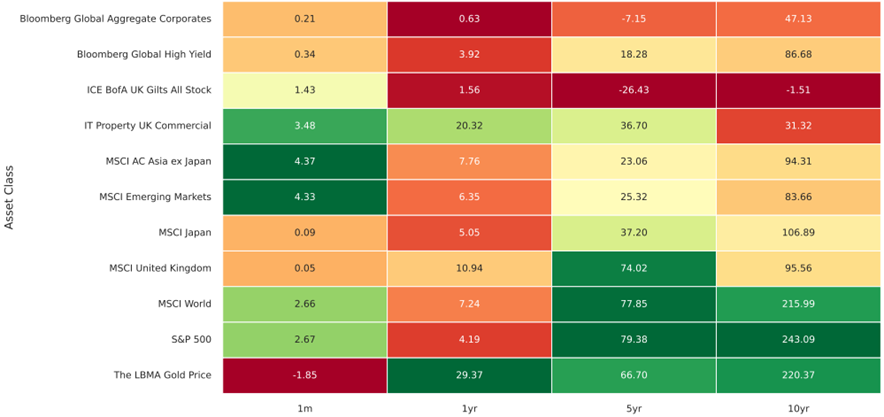Global markets summary
June 2025 proved to be a month of notable divergence across global financial markets, characterised by resilient equity performance amid persistent fixed income volatility. Sterling-based investors witnessed particularly strong performance from MSCI Asia Pacific, bolstered by sustained dollar weakness that channelled capital towards Asian markets. Korea and Taiwan emerged as notable beneficiaries, with their currencies strengthening against the greenback. European and American equities similarly advanced, underpinned by diminishing geopolitical concerns and robust corporate profitability, though sterling investors saw US returns tempered by currency movements. The UK market delivered modest gains despite experiencing intra-month volatility, oscillating between a peak near 8,902 and a trough around 8,707. In contrast, the fixed income sphere endured considerable turbulence as long-dated yields climbed markedly.
Market sentiment throughout June reflected the intricate dynamics of macroeconomic and geopolitical developments. Initial military tensions between Israel and Iran propelled oil prices beyond $80 per barrel, stoking stagflationary fears among investors. The subsequent diplomatic breakthrough and ceasefire agreement provided significant relief, allowing oil prices to retreat and market anxiety to subside. Concurrently, dollar weakness strengthened both sterling and the euro, enhancing the relative attractiveness of UK and European assets for domestic investors.
Our forward-looking perspective remains constructively positioned towards global equities, underpinned by a commitment to geographical and stylistic diversification. The confluence of coordinated fiscal stimulus across developed economies, sustained technological innovation, and improving corporate earnings visibility reinforces our preference for equities. Within fixed income, we maintain a measured approach, avoiding duration (interest rate sensitivity) risk in favour of shorter-maturity instruments and carefully selected credit opportunities, while remaining vigilant to evolving central bank policy trajectories.
The global economic landscape is undergoing profound transformation. In response, we have carefully designed our portfolios to harness potential market upswings while maintaining robust safeguards against unexpected market turbulence.
What is ‘stagflation’?
Stagflation is an economic condition where inflation is high, economic growth is slow or stagnant, and unemployment is also high – all happening at the same time.
Normally, inflation and unemployment don’t rise together. But in stagflation, prices go up (reducing purchasing power), while the economy isn’t growing enough to create jobs or boost incomes. This makes it particularly difficult for policymakers, because the usual tools to fight inflation (like raising interest rates) can make unemployment worse, and vice versa.
United Kingdom
UK equities delivered a period of relative underperformance against broader global markets during June, despite having generated solid outperformance year to date. This divergence occurred against a backdrop of mixed domestic economic indicators that continue to present a complex picture for investors and policymakers alike.
Consumer confidence surveys maintained their trajectory of gradual improvement, extending a trend observed in recent months. However, this positive sentiment has yet to translate into robust spending patterns. The Purchasing Managers Index demonstrated resilience by recovering in May following April’s decline, which had coincided with peak uncertainty surrounding potential tariff implementations. Nonetheless, GDP growth disappointed expectations, reinforcing concerns about the underlying strength of the economic recovery.
The Bank of England’s Monetary Policy Committee elected to maintain the base rate at 4.25%, a decision that reflected both the mixed economic data and ongoing geopolitical uncertainties, particularly regarding Middle Eastern tensions and trade policy developments. With inflation data aligning with forecasts in June, market participants increasingly anticipate a rate reduction when the Committee reconvenes in August.
The case for monetary easing appears compelling given the persistent low-growth environment. While the Government has emphasised growth as a central policy objective, several policy decisions appear to have produced counterproductive outcomes. The unveiling of Labour’s industrial strategy in June offered some encouragement, though investors remain cautious pending evidence of tangible implementation and measurable benefits.
The industrial strategy addresses two critical structural challenges: the UK’s elevated electricity costs relative to European and US counterparts, and the need to attract skilled labour more effectively. The Government has identified high-growth sectors as focal points, specifically highlighting opportunities in electric vehicles, defence technology, and artificial intelligence. While these sectors represent current market preferences, the UK’s capacity to achieve genuine global competitiveness in these areas remains subject to scrutiny.
The Government’s credibility challenge represents a more fundamental concern. Despite commanding a substantial parliamentary majority, proposed welfare reforms have encountered significant internal opposition. The Prime Minister’s subsequent reversal of these measures has added £4.25 billion to budgetary commitments, intensifying pressure on the Chancellor and prompting speculation regarding potential tax increases in the forthcoming Autumn Budget.
While the Autumn Budget undoubtedly presented headwinds for economic growth, we maintain our conviction that selected companies are well-positioned to benefit from the Government’s longer-term spending commitments. The full impact of fiscal stimulus measures has yet to materialise, and the subdued growth environment strengthens the rationale for accommodative monetary policy, which should provide tailwinds for UK equities. We anticipate that small- and mid-cap companies will derive particular benefit from lower interest rates, reflecting our continued overweight allocation to this segment within our UK Dynamic Fund.
North America
The American equity market demonstrated impressive momentum throughout June, with major indices achieving new record highs despite ongoing uncertainty surrounding trade policy and fiscal dynamics. The S&P 500 breached the 6,150 level for the first time, while the technology-heavy Nasdaq Composite similarly reached unprecedented heights, driven by sustained optimism around artificial intelligence applications and the prospect of monetary policy easing. This performance occurred against a backdrop of mixed economic indicators, with core inflation remaining stubbornly above target at 2.7% year on year while consumer sentiment improved markedly as tariff concerns moderated.
Sterling-based investors in US equities experienced a notable currency headwind during June, with the S&P 500 delivering returns of just over 3% in GBP terms compared to its robust 5% performance in USD. The dollar’s depreciation against sterling during the month eroded approximately 200 basis points of returns for UK investors, underscoring the significant impact that foreign exchange movements can have on international portfolio performance. This dynamic represents a marked reversal from the prevailing trend of recent years, where persistent dollar strength has served as a valuable tailwind for sterling-based investors, often enhancing their returns from US equity allocations. The June experience serves as a timely reminder of the dual nature of currency risk in international investing, where exchange rate movements can either amplify or diminish underlying asset returns.
The Federal Reserve’s preferred inflation gauge showed modest upward pressure during the month, yet market participants increasingly priced in potential rate reductions for the latter half of 2025. This dovish repricing reflected growing confidence that policymakers would prioritise economic growth amid softening labour market conditions and decelerating business activity indicators. The flash Purchasing Managers’ Index readings suggested continued expansion but at a more moderate pace, with manufacturing showing tentative signs of recovery while services momentum eased.
Corporate fundamentals remained broadly supportive, with share buyback programmes continuing at a robust pace approaching $1 trillion annually, while new equity issuance remained subdued. This technical imbalance between supply and demand provided crucial support for valuations, even as the market’s concentration in mega-cap technology names raised concerns about breadth. The narrow leadership, with six companies accounting for over half of the S&P 500’s gains since late May, highlighted the importance of stock selection within the American market.
We maintain a balanced perspective on US equities, acknowledging the structural advantages of American companies’ innovation capabilities and market depth while remaining cognisant of elevated valuations and concentration risks. Selective exposure, particularly in value-oriented and cyclical sectors, may offer more attractive risk-adjusted returns.
Europe
European equity markets delivered compelling performance during June, with particular strength evident in smaller and medium-sized companies that significantly outpaced their larger counterparts. The MSCI Europe small- and mid-cap index surged over 10% year to date, reflecting investor enthusiasm for the region’s economic renaissance potential, particularly following Germany’s announcement of an unprecedented €1 trillion stimulus programme. This marked divergence from US smaller companies, which struggled amid domestic economic uncertainties, underscored the shifting dynamics of global capital allocation.
The region’s economic indicators painted a nuanced picture, with composite Purchasing Managers’ Index readings hovering just above the expansion threshold at 50.2, suggesting modest but positive momentum. While France continued to face headwinds with its economy remaining in contractionary territory for a tenth consecutive month, Germany showed encouraging signs of recovery, and business confidence reached one-year highs on expectations of increased government spending. The inflation landscape remained relatively benign compared to other developed markets, providing European Central Bank policymakers with greater flexibility in their monetary stance.
Market sentiment received additional support from the relative insulation of European companies from global trade tensions, with investors viewing the region as a potential beneficiary of supply chain diversification efforts. The combination of reasonable valuations, improving economic momentum, and substantial fiscal support created a favourable backdrop for continued outperformance. Currency dynamics also played a supportive role, with the euro strengthening against the dollar and enhancing the region’s attractiveness to international investors.
Our outlook for European equities remains constructive, particularly for domestically-oriented companies that stand to benefit from fiscal expansion and economic normalisation. We favour exposure to smaller companies and sectors aligned with the region’s strategic priorities, including defence, infrastructure, and green transition initiatives, while maintaining selective positions in high-quality multinational corporations trading at attractive valuations.
Rest of the world
Japanese equities delivered strong performance in June, with the TOPIX index advancing 2.6% despite ongoing uncertainty about the Bank of Japan’s monetary policy trajectory. Technology stocks led the advance as global risk appetite improved following the Middle East ceasefire, while the yen’s modest strengthening to 144.7 against the dollar from 146.1 provided additional stability. Tokyo-area inflation data showed a deceleration to 3.1% year on year, though remaining well above the central bank’s target, suggesting continued support for gradual policy normalisation while maintaining an accommodative stance to support economic growth.
Asia-Pacific markets excluding Japan reached multi-year highs, with the MSCI index touching levels not seen since November 2021. This broad-based rally reflected improving sentiment around regional growth prospects and reduced concerns about trade disruptions following diplomatic progress between major economies. Chinese equities participated in the regional upswing, with the CSI 300 and Shanghai Composite indices both gaining over 2% as news emerged of a trade understanding with the United States. The agreement, while limited in scope, helped stabilise bilateral relations and provided a foundation for continued economic engagement.
Emerging markets delivered exceptional returns during June, with the MSCI Emerging Markets index advancing 3.4% for the month and an impressive 16% year to date. This outperformance reflected multiple supportive factors, including attractive valuations, improving domestic demand dynamics, and substantial capital inflows seeking diversification away from expensive developed market assets. Latin American markets showed mixed performance, with Mexico benefiting from continued rate cuts by its central bank, while Brazil maintained steady growth momentum with upgraded GDP forecasts approaching 2.1% for 2025.
Fixed income
Over June, fixed income performance varied considerably across sectors for sterling-based investors, with domestic credit leading returns. Sterling corporate bonds delivered the strongest performance at 1.71%, followed by UK gilts at 1.52% and global emerging market bonds at 1.45%. Sterling high-yield bonds generated a respectable 1.16%, demonstrating continued appetite for credit risk.
A particularly striking feature was the divergent performance of US Treasury exposure. Hedged US Treasury positions produced a notable negative return of -0.32%, while unhedged equivalents delivered a positive 1.26%. This 158 basis-point differential underscores the significant impact of currency movements during the period, with sterling appreciation eroding returns for currency-hedged positions while enhancing those with full dollar exposure.
This disparity highlights the critical importance of currency hedging decisions in international fixed income allocations. For sterling-based investors, unhedged Treasury positions not only avoided losses but actually outperformed sterling high-yield bonds, traditionally a higher-risk asset class. Such dynamics reinforce the complexity of navigating global bond markets, where currency considerations can overwhelm underlying yield movements and fundamentally alter the risk-return profile of seemingly defensive assets.
Our fixed income positioning remains defensively oriented, with a strong preference for shorter-duration instruments and high-quality credit over long-dated government bonds. We view the current yield environment as offering selective opportunities for income generation while advocating caution on duration extension given fiscal and inflation uncertainties. Emerging market debt continues to offer attractive risk-adjusted returns for suitable investors, while we maintain an underweight stance on developed market sovereign debt.
Ask us anything
Q: Now we’re at the six-month mark, what is your outlook for the rest of the year?
A: Now we’re at the midpoint of 2025, markets continue to be shaped by a shifting narrative, one largely driven by US policy developments and evolving global dynamics. The first half of the year has been marked by volatility, not only in asset prices but also in the underlying economic data. While tariff threats have de-escalated, the lingering uncertainty has left a more permanent mark on investor sentiment and corporate behaviour. The broader theme emerging is one of fragmentation, as the world moves further away from the globalisation playbook that defined previous decades.
This uncertainty has translated into softer corporate and consumer demand, with many businesses delaying investment decisions and reassessing supply chains. Confidence indicators have swung with the headlines, while hard data – particularly employment and inflation – have remained more resilient, creating a foggy and at times contradictory economic picture. Although consumer sentiment showed signs of recovery in May, it remains subdued, and the US housing market is beginning to show signs of strain.
Looking ahead to the second half of the year, we see global growth and inflation at a crossroads. Disruptive trade policies have created divergent economic shocks – supply-side in the US – demand-side elsewhere, undermining momentum. While the pause in reciprocal tariffs offers some relief, near-term growth remains under pressure. However, fiscal interventions, including US tax cuts, European infrastructure spending, and potential Chinese stimulus, may help cushion the impact over the medium term.
We are closely watching central bank policy, particularly the US Federal Reserve’s delicate balancing act between inflation risks and a weakening economy. Other central banks, facing less inflationary pressure, may have more room to ease. Yet the greatest risk may be complacency. The perceived buffer of US shale masks deeper vulnerabilities in global supply chains. A misstep, whether geopolitical or policy-driven, could quickly reignite inflation and market instability.
In this environment, we believe diversification is paramount. Our portfolios are positioned to capture upside participation while maintaining resilience against unforeseen shocks. We continue to favour a ‘broadening out’ approach, identifying opportunities not only within the US but also across developed and emerging markets. Value stocks, in particular, offer compelling potential, especially in an inflationary backdrop where richly priced growth names may struggle.
In equities, we maintain a positive stance on international markets relative to the US, supported by more attractive valuations and the prospect of rate cuts. The UK is exploring structural reforms that could benefit mid- and small-cap segments. In fixed income, we remain cautious on developed market sovereigns given higher trend inflation and fiscal deficits, but see attractive yield and diversification potential in actively managed emerging market debt.
The global economic landscape is shifting. As ever, our focus remains on navigating this complexity with discipline and foresight – seeking to protect capital while uncovering opportunities in a world that is becoming ever more fragmented.
Key takeaways
- Markets remain volatile and fragmented, with shifting trade policies and geopolitical uncertainty weighing on confidence, investment, and global growth prospects.
- Diversification and selectivity are key, as we favour a broadening out across regions and sectors, particularly value stocks and international equities, amid an evolving macroeconomic backdrop.
- Risks remain elevated, especially around energy security and inflation, but fiscal support and central bank flexibility may help cushion the path forward.
If there is a question you’d like to pose to our team, please reply to this email or write to [email protected].
MARKET DATA

All performance figures are from FE analytics (as at 30/06/2025) and quoted on a total return basis in pounds sterling.
The Monthly Market Commentary (MMC) is written and researched by Scott Bradshaw, Lauren Hyslop and Jonathon Marchant for clients and professional connections of Mattioli Woods and is for information purposes only. It is not intended to be an invitation to buy, or to act upon the comments made, and all investment decisions should be taken with advice, given appropriate knowledge of the investorʼs circumstances. The value of investments and the income from them can fall as well as rise and investors may not get back the full amount invested. Past performance is not a guide to the future.
Mattioli Woods Limited is authorised and regulated by the Financial Conduct Authority.
Sources: All other sources quoted if used directly, except fund managers who will be left anonymous; otherwise, this is the work of Mattioli Woods.




